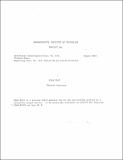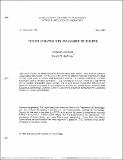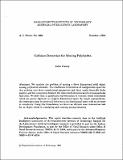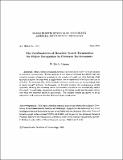Browsing AI Memos (1959 - 2004) by Title
Now showing items 109-128 of 1217
-
CHAR PLOT
(1966-10-01)CHAR PLOT is a routine which enables one to use the Calcomp plotter as an output typewriter. This program is stored as CHPLOT BIN [English CHAR PLOT]. In use a code, representing a character of command as defined in Appendix ... -
CHAR PLOT
(1967-03-01)CHAR PLOT is a routine which enables one to use the CalComp plotter as a versatile output device. It is presently available as CHPLOT BIN (English CHAR PLOT) on tape MS 3. The program CHAR PLOT is normally called by a PUSHJ ... -
Character-Handling Facilities in the LISP System
(1961-01-01)Because of the new read program, a number of facilities are being added to the LISP system to permit manipulation of single characters and print names. Machine-language functions have been provided for breaking print names ... -
Characterization of Joint-Interpolated Arm Movements
(1985-06-01)Two possible sets of planning variables for human arm movement are point angles and hand position. Although one might expect these possibilities to be mutually exclusive, recently an apparently contradictory set of ... -
Circumscribing Circumscription: A Guide to Relevance and Incompleteness
(1985-10-01)Intelligent agents in the physical world must work from incomplete information due to partial knowledge and limited resources. An agent copes with these limitations by applying rules of conjecture to make reasonable ... -
Classifying Objects from Visual Information
(1986-06-01)Consider a world of 'objects.' Our goal is to place these objects into categories that are useful to the observer using sensory data. One criterion for utility is that the categories allow the observer to infer the ... -
A Closed Form Solution for Inverse Kinematics of Robot Manipulator with Redundancy
(1986-03-01)A closed form equation for inverse kinematics of manipulator with redundancy is derived, using the Lagrangian multiplier method. The proposed equation is proved to provide the exact equilibrium state for the resolved ... -
CNTOUR
(1968-01-01)The CNTOUR program plots an intensity relief map of an image which is read from tape, disc, or from either vidisector camera. It is used to examine vidisector images. It may also be used as a general purpose aiming, ... -
Co-dimension 2 Geodesic Active Contours for MRA Segmentation
(1999-08-11)Automatic and semi-automatic magnetic resonance angiography (MRA)s segmentation techniques can potentially save radiologists larges amounts of time required for manual segmentation and cans facilitate further data analysis. ... -
Codon Constraints on Closed 2D Shapes
(1984-05-01)Codons are simple primitives for describing plane curves. They thus are primarily image-based descriptors. Yet they have the power to capture important information about the 3-D world, such as making part boundaries ... -
Collision Detection for Moving Polyhedra
(1984-10-01)We consider the problem of moving a three dimensional solid object among polyhedral obstacles. The traditional formulation of configuration space for this problem uses three translational parameters and three angles ... -
Color Vision and Image Intensities: When Are Changes Material?
(1981-05-01)Marr has emphasized the difficulty in understanding a biological system or its components without some idea of its goals. In this paper, a preliminary goal for color vision is proposed and analyzed. That goal is to ... -
Color Vision: Representing Material Categories
(1984-05-01)We argue that one of the early goals of color vision is to distinguish one kind of material from another. Accordingly, we show that when a pair of image regions is such that one region has greater intensity at one wavelength ... -
The Combinatorics of Heuristic Search Termination for Object Recognition in Cluttered Environments
(1989-05-01)Many recognition systems use constrained search to locate objects in cluttered environments. Earlier analysis showed that the expected search is quadratic in the number of model and data features, if all the data comes ... -
The Combinatorics of Local Constraints in Model-Based Recognition and Localization from Sparse Data
(1986-03-01)The problem of recognizing what objects are where in the workspace of a robot can be cast as one of searching for a consistent matching between sensory data elements and equivalent model elements. In principle, this ... -
The Combinatorics of Object Recognition in Cluttered Environments Using Constrained Search
(1988-02-01)When clustering techniques such as the Hough transform are used to isolate likely subspaces of the search space, empirical performance in cluttered scenes improves considerably. In this paper we establish formal bounds ... -
COMEX: A Support System for a Commodities Expert
(1977-08-01)The intelligent support system project is developing a program (COMEX) to assist a commodities expert in tasks such as interpreting data, predicting trends and intelligent noticing. Large amounts of qualitative and ... -
The COMIT Feature in LISP II
(1965-02-01)The purpose of COMIT feature is to facilitate certain types of list manipulations in LISP II. This feature is a syntactic convenience, rather than an extension of the semantics of LISP. It permits the programmer to test ... -
Commenting Proofs
(1974-05-01)This paper constitutes a summary of a seminar entitled "Commenting Proofs" given a the Artificial Intelligence Laboratory during the spring of 1974. The work is concerned with new syntactic structures in formal proofs ... -
Comparative Analysis
(1987-11-01)Comparative analysis is the problem of predicting how a system will react to perturbations in its parameters, and why. For example, comparative analysis could be asked to explain why the period of an oscillating ...




















